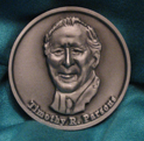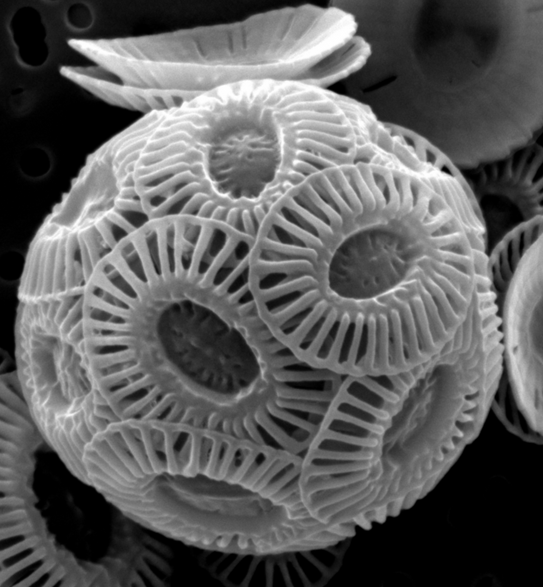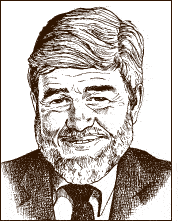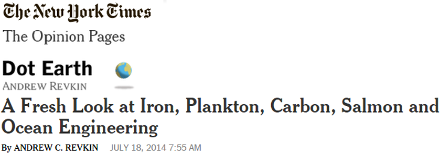
Tim Parsons And The New York Times
The New York Times DotEarth Blog has a posting about me and my work.
My 2012 ocean pasture restoration project nourished and is bringing hundreds of millions of additional salmon into the nets and onto our plates.
But my simple good news for the planet story it seems isn’t sufficient.
I had agreed to talk with Andrew Revkin of the Times when he assured me he was not working on a “he said – she said” fight story about the controversy fomented around my work to restore ocean pastures. I took him at his word and we had an hours long SKYPE conversation where I filled him in on myriad details.
But alas he’s a clever boy and while he doesn’t bash me directly in his report and does give some short shrift to my good news for the planet; he also elected to link the worst of the Troll Bait pack of lies stories about me on the internet to his blog post. If he could I am sure he’d have sic’d a Kraken on me.
I was expecting, as promised, that the blog would also provide a means to carry on an intelligent “discussion” on the topic. Okay that sounded reasonable…. but then…..
One of the comments to the DotEarth Blog has come from Tim Parsons, Canada’s most eminent ocean scientist. I have counted on Tim’s advice in my work so I thought I would comment on the NYT site in reply to Tim’s comments. Alas the NYT in it’s wisdom has decided that I may not comment on the blog about me save in an crippling and misleading abbreviated fashion.
So here’s my comment to Tim Parson NYT DotEarth words. I’ve added some images to make the reading and comprehension easier.
My response to Tim Parsons on DotEarth
As Tim knows very well he and I spoke about his and my ideas regarding ocean ecology and trophodynamics before I choose the location for my work in the summer of 2012. Curiously at the time Tim wanted to meet NOT at his office at the Institute of Ocean Sciences to talk with me. Instead he and his institute colleague insisted we meet in the dark of night at a remote diner away from the institute. Keep in mind this secretive meeting took place weeks before I set to sea on my research ship to do the work of ocean pasture restoration.
Tim and his colleague explained to me this secretive meeting was due to what they referred to as “my being black-listed by the Canadian government and it’s so called public service.” I was delighted to meet Tim anywhere on any terms as his ocean wisdom in this part of the world is second to none. That Tim was in fear as an octogenarian emeritus scientist of his Fisheries and Oceans Institute masters was and is curious.
Tim and I agree that looking to the more trophically advantageous phytoplankton is a good thing if one is seeking large gains in net primary productivity (NPP). Both diatoms and cocolithophores deliver these large trophic NPP gains and my work of 2012 showed this in spades and species.
As Tim also knows and we discussed how there is a progression of changing speciation in large sustainably managed ocean pastures and their blooms, and this was confirmed in my 2012 project. The phyto-plankton goes through a steady shift in species and biodiversity which I simplify in describing how phyto-plankton grow larger and more difficult to eat as the bloom progresses. This is naturally due to the grazing pressure of zooplankton who find eating the littlest softest phyto-plankton first the easiest thus selecting for growth of harder to eat stuff.
Surely no one with half a plankton brain suggests the simpleton notion that the “ocean” is one universally iron deficient pool of water. That’s obvious from a century of good data. But there are vast areas of the world’s oceans that are deplete in iron and the fact that iron is arriving in the oceans in diminishing amounts is unquestioned. John Martin my personal hero in this field did extensive work on this in the 1970’s to early 1990’s and was the first to propose and plan an iron replenishment IronEX1.
This story of my 2012 ocean pasture restoration ought to be considered within the context of scores of reporting scientists in many institutions making decades of salmon forecasts that have been traditionally accurate with regard to salmon returns in the region. Those forecasts take into consideration supposedly ALL pertinent factors both local and global, including the mysterious Pacific Decadal Oscillation (PDO).
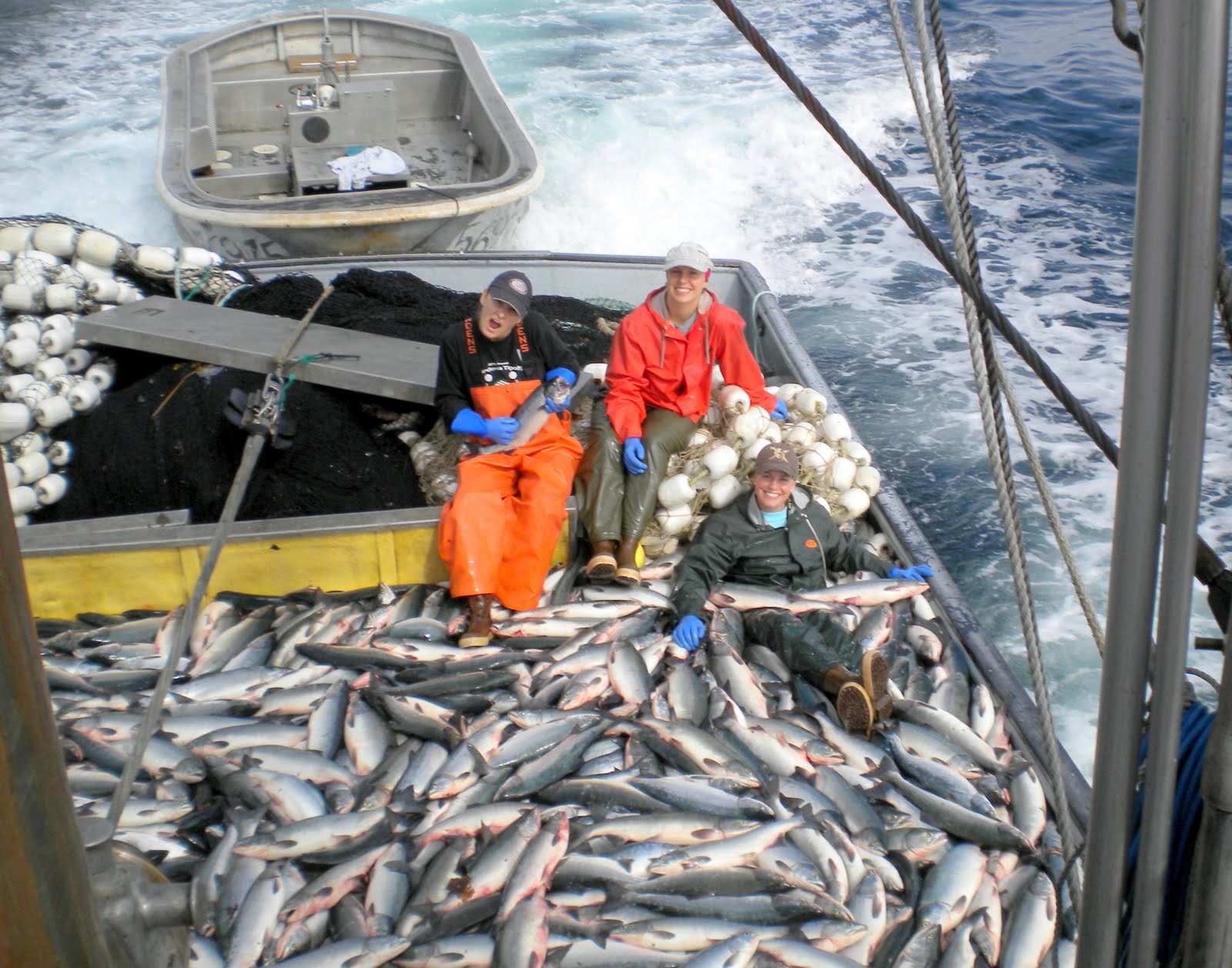
The Fish Came Back From Our Restored Ocean Pasture Producing The Largest Catch Of Salmon In Alaskan History
In-spite of the forecast for 50 million Pink salmon to be caught in SE Alaska in 2013 the facts are strikingly different. Following my restoration and revival of a vast ocean pasture, the key nursery pasture for SE Alaska Pink salmon, the fish came back not in small increments over the forecasts but in overwhelming numbers of 226 million Pinks caught instead of 50 million. A number that far exceed any previous forecast errors. Read more on The Fish Came Back
I have now demonstrated at large scale the know-how to Bring The Fish Back year after year after year and it doesn’t require the hundreds of millions per year spent by Tim and his institutional salmon cabal. The cost to return salmon to historic abundance in the NE Pacific is mere pennies on the current salmon management dollar.
My low-cost, immediately deployable, proven effective new technology and methodology that was NOT INVENTED by Tim and his cronies in the salmon establishment seems to also NOT be welcome news to them. The “black listing remains, more potent than ever.” But hey….
ps… OK Andrew your clear-eyed Skype sincerity caught me, let’s have at it.
Go ahead and tell him to say it, you know you want to!
Release The Kraken
ps.
I received some many emails about the DotEarth blog post. Most said “well it was pretty good, at least not as bad as many news stories about you.”
One email came from a friend who is now retired from a career as a very well known journalist, whose name I will keep secret. I’d sent him a note alerting him to the DotEarth treatment and my reply via blog post here. His reply is just too funny to not include here in-spite of … well you’ll see. Here it is.
Sent: July 19, 2014 5:03 PM
To: Russ George
Subject: Re: news on me and my work to bring back the fish
You are not the first to trust an untrustworthy journalist, and will not be the last, alas. I have even gone through it myself. They always have that clear-eyed air of sincerity, as if they want to do the right thing. And then they betray you.
Hunter Thompson had it right. He consented an interview with a female journalist if she would agree to be photographed licking whipped cream off his penis. He would hold the picture as a security against her betraying him when she wrote about him. Unfortunately she didn’t go for the deal. But that’s the kind of thing you would have to do, to get a typical East Coast journalist to honor a commitment.









